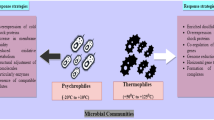Abstract
The strength and regulatory characteristics of the heat-inducibleHSA1, HSA2 andTPS1 promoters were compared with those of the well-established, carbon source-regulatedFMD promoter in aHansenula polymorpha-based host systemin vivo. In addition, theSaccharomyces cerevisiae-derivedADH1 promoter was analysed. WhileADH1 promoter showed to be of poor activity in the foreign host, the strength of the heat shockTPS1 promoter was found to exceed that of theFMD promoter, which at present is considered to be the strongest promoter for driving heterologous gene expression inH. polymorpha.
Similar content being viewed by others
References
Gellissen, G. and C. P. Hollenberg (1997) Application of yeasts in gene expression studies: A comparison ofSaccharomyces cerevisiae, Hansenula polymorpha andKluyveromyces lactis—a review.Gene 190: 87–97.
Gellissen, G. and C. P. Hollenberg (1999)Hansenula. pp. 976–982. In: R. K. Robinson, C. Batt and P. D. Patel (eds.)Encyclopedia of Food Microbiology, Vol. 2. Academic Press. San Diego, CA, USA.
Gellissen, G., C. P. Hollenberg, and Z. A. Janowicz (1995) Gene expression in methylotrophic yeasts. pp. 395–439 In: A. Smith (ed.)Gene Expression in Recombinant Microorganisms. Marcel Dekker, New York, NY, USA.
Mayer, A. F., K. Hellmuth, H. Schlieker, R. Lopez-Ulibarri, S. Oertel, U. Dahlems, A. W. Strasser, and A. P. van Loon (1999) An expression system matures: A highly efficient and cost-effective process for phytase production by recombinant strains ofHansenula polymorpha.Biotechnol. Bioeng. 63: 73–381.
Cox, H., D. Mead, P. Sudbery, M. Eland, and L. Evans (2000) Constitutive expression of recombinant proteins in the methylotrophic yeastHansenula polymorpha using thePMA1 promoter.Yeast (in Press).
Brito, N., M. D. Peréz, G. Perdomo, C. González, P. Garcia-Lugo, and J. M. Siverio (1999) A set ofHansenula polymorpha integrative vectors to constructlacZ fusions.Appl. Microbiol. Biotechnol. 53: 23–29.
Reinders, A., I. Romano, A. Wiemken, and C. de Virgilio (1999) The thermophilic yeastHansenula polymorpha does not require trehalose synthesis for growth at high temperatures but does for normal acquisition of thermotolerance.J. Bacteriol. 181: 4665–4668.
Titorenko, V. I., M. E. Evers, A. Diesel, B. Samyn, J. Van Beeumen, R. Roggenkamp, J. A. Kiel, I. J. van der Klei, and M. Veenhuis (1996) Identification and characterization of cytosolicHansenula polymorpha proteins belonging to the Hsp70 protein family.Yeast 12: 849–857.
Diesel, A. (1997) Die hsp70-Gene der Methylotrophen HefeHansenula polymerpha. Ph. D. Thesis, Heinrich-Heine-Universität, Düsseldorf, Germany.
Thevelein, J. M. (1996) Regulation of trehalose metabolism and its relevance to cell growth and function. pp. 395–420. In: R. Bramble and G. A. Marzluf (eds.)The Mycola III. Springer Verlag, Berlin, Germany.
Bogdanova, A. I., O. S. Kustikova, M. O. Agaphonov, and M. D. Ter-Avenesyan (1998) Sequences ofSaccharomyces cerevisiae 2 μm DNA improving plasmid partitioning inHansenula polymorpha.Yeast 14: 1–9.
Sohn, J. H., E. S. Choi, C. H. Kim, M. C. Agaphonov, M. D. Ter-Avenesyan, J. S. Rhee, and S. K. Rhee (1996) A novel autonomously replicating sequence (ARS) for multiple integration in the yeastHansenula polymorpha DL-1.J. Bacteriol. 178: 4420–4428.
Sohn, J. H., E. S. Choi, H. A. Kang, J. S. Rhee, and S. K. Rhee (1999) A family of telomere-associated autonomously replicating sequences and their function in targeted recombination inHansenula polymorpha DL-1.J. Bacteriol. 18: 1005–1013.
Agaphonov, M. O., M. Y. Beburov, M. D. Ter-Avanesyan, and V. N. Smirnov (1995) A disruption-replacement approach for the targeted integration of foreign genes inHansenula polymorpha.Yeast 11: 1241–1247.
Janowicz, Z. A., K. Melber, A. Merckelbach, E. Jacobs, N. Harford, M. Comberbach, and C. P. Hollenberg (1991) Simultaneous expression of the S and L surface antigens of hepatitis B, and formation of mixed particles in the methylotrophic yeast.Hansenula polymorpha. Yeast 7: 431–443.
Zurek, C., E. Kubis, P. Keup, D. Hörlein, J. Beunink, J. Thömmes, R. M. Kula, C. P. Hollenberg, and G. Cellissen (1996) Production of two aprotinin variants inHansenula polymorpha.Process Biochem. 31: 679–689.
Gatzke, R., U. Weydemann, Z. A. Janowicz, and C. P. Hollenberg (1995) Stable multicopy integration of vector sequences inHansenula polymorpha.Appl. Microbiol. Biotechnol. 43: 844–849.
Suckow, M. and C. P. Hollenberg (1998) The activation specificities of wild-type and mutant Gcn4pin vivo can be different from the DNA binding specificites of the corresponding bZip peptidesin vitro.J. Mol. Biol. 176: 887–902.
Bradford, M. M. (1976) A rapid and sensitive method for the quantification of microgram quantities of protein utilizing the principle of protein-dye binding.Anal. Biochem. 72: 248–254.
Miller, J. H. (1972)Experiments in Molecular Genetics. Cold Spring Harbor Laboratory Press, Cold Spring Harbor, NY, USA.
Niedenthal, R. K., L. Riles, M. Johnston, and J. H. Hegemann (1996) Green fluorescent protein as a marker for gene expression and subcellular localization in budding yeast.Yeast 2: 773–786.
Lim, C. R., Y. Kimata, M. Oka, K. Nomaguchi, and K. Kochno (1995) Thermosensitivity of green flourescent protein flourescence utilized to reveal novel nuclear like compartments in a mutant nucleoporin NSP1.J. Biochem. 118: 13–17.
Hinnen, A., F. Buxton, B. Chaudhuri, J. Heim, T. Hottiger. B. Meyhack, and G. Pohlig (1995) Gene expression in recombinant yeast. pp. 121–193 In: A. Smith (ed.)Gene Expression in Recombinant Microorganisms. Marcel Dekker New York, NY, USA.
Gellissen, G., Z. A. Janowicz, U. Weydemann, K. Melber, A. W. M. Strasser, and C. P. Hollenberg (1992) High-level expression of foreign genes inHansenula polymorpha.Biotech. Adv. 10: 179–189.
Gellissen, G., C. P. Hollenberg, and Z. A. Janowicz (1994) Gene expression in methylotrophic yeasts. pp. 195–239 In: A. Smith (ed.)Gene Expression in Recombinant Microorganisms. Marcel Dekker, New York, NY, USA.
Denis, C. L., J. Ferguson, and E. T. Young (1983) mRNA levels for the fermentative alcohol dehydrogenase ofSaccharomyces cerevisiae decrease upon growth on a non-fermentable carbon source.J. Biol. Chem. 258: 1165–1171.
Author information
Authors and Affiliations
Corresponding author
Rights and permissions
About this article
Cite this article
Amuel, C., Gellissen, G., Hollenberg, C.P. et al. Analysis of heat shock promoters inHansenula polymorpha: TheTPS1 promoter, a novel element for heterologous gene expression. Biotechnol. Bioprocess Eng. 5, 247–252 (2000). https://doi.org/10.1007/BF02942181
Received:
Accepted:
Issue Date:
DOI: https://doi.org/10.1007/BF02942181




